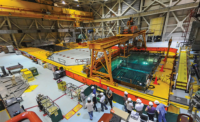One of Chicago’s hottest new boutique hotels is also proving to be high on the energy-efficiency list.


Since opening in July, theWit, located on State Street in downtown Chicago, has been creating buzz with its exciting atmosphere, and even though the hotel exudes high energy, the building itself uses amazingly little.
In fact, the electric bill for the 27-story, 298-room hotel has run only about $7,000 per month, including power for three restaurants.
Even though the nearly 300,000-sq-ft hotel was designed to be energy efficient, its owners expected to see electric bills of about $18,000 per month. But designed-in energy-saving systems have worked even better than expected and have cut electrical expenses to 62% of that amount.
In addition, theWit uses less than half as much natural gas as a typical hotel of its size, according head engineer Mark Wrobel, a veteran hotel physical plant manager.
The building’s low energy consumption comes from a combination of several carefully designed efficiency features.
One is extensive use of LED lighting, which draws less current per unit of illumination than incandescent lighting and generates less heat. The building also uses some incandescent and other types of lights where they are best choice.
“Designing lighting that is both effective and energy efficient requires asking what we’re trying to accomplish in a specific area, then choosing the right size and type of light fixture for the application,” says Avraham Mor, partner in Lightswitch Architectural of Chicago, which designed theWit’s lighting. The lighting system at theWit delivers impact while using just 1.1 watts of electricity per sq ft.
In addition to energy-efficient lighting, the building focuses on saving energy in its other systems, too.
The windows are double insulated and also designed to deaden noise.
A major key to controlling energy useage throughout the structure is the building automation software that controls the boilers, air handlers, cooling towers, heat pump and radiators in the lobby and meeting spaces, as well as temperature and lights in unoccupied rooms throughout the building. The software’s reporting feature lets the building’s facility manager see what’s going on in any of the facility’s systems conveniently from a laptop computer.
One interesting way the energy-management system saves energy costs is by talking to the hotel’s booking computers, then turning the temperature in any unoccupied guest room down to 65 degrees and turning off any lights that are on in the room. When the booking computer checks a guest into a room, the room’s thermostat automatically regains control of the temperature.
Occupancy sensors in all of the meeting areas turn lights off and lower the temperature when no one is using the space.
The air-handling system also saves on electricity by using just one makeup air handler for all public spaces, and just three overall, instead of the eight typically used for a building of theWit’s size. And all of the fans are run by variable-frequency drives so their speeds (and electrical consumption) can be adjusted as air-flow requirements change.
The building uses a heat pump to capture and reuse heat generated by HVAC units, coolers and freezers in the restaurant kitchens, ice machines on the guest floors and the building’s mechanical equipment. Reusing waste heat from equipment has enabled theWit to reduce the operation time of its boilers, and in turn to cut its natural gas consumption by 50%, Wrobel says.


